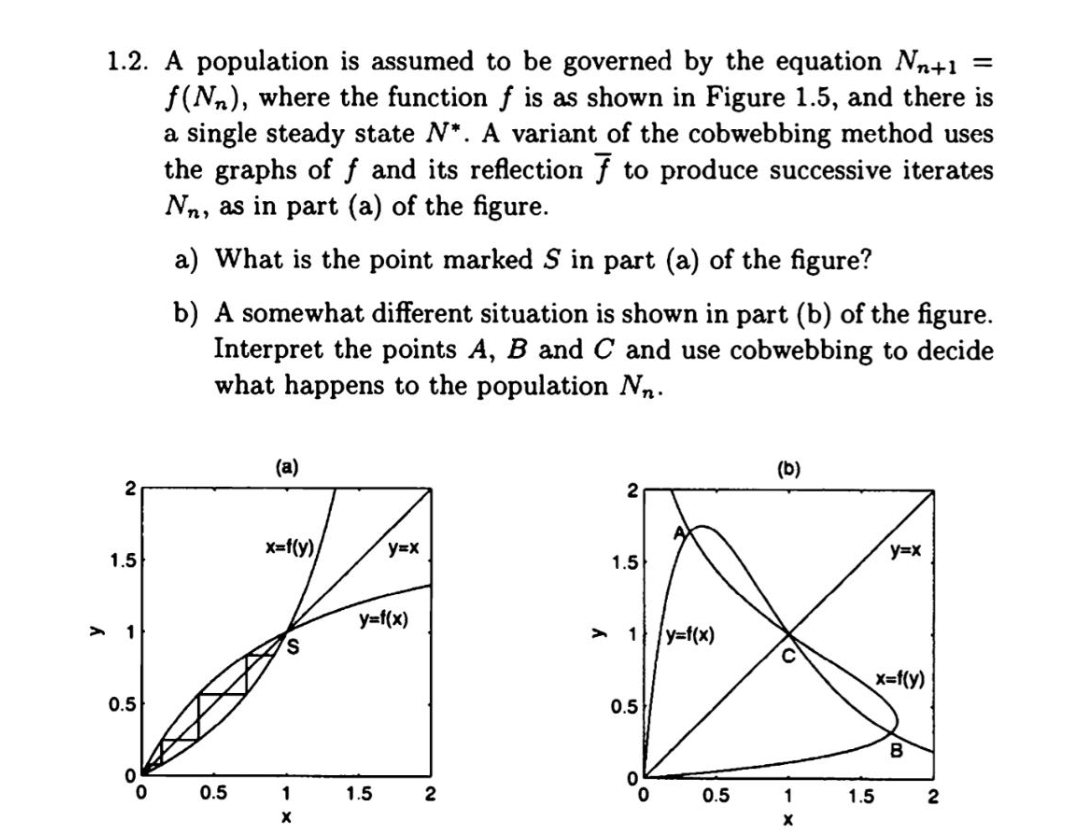1.2. A population is assumed to be governed by the equation Nn+1 = f(Nn), where the function f is as shown in Figure 1.5, and there is a single steady state N*. A variant of the cobwebbing method uses the graphs off and its reflection f to produce successive iterates Nn, as in part (a) of the figure. %3D a) What is the point marked S in part (a) of the figure? b) A somewhat different situation is shown in part (b) of the figure. Interpret the points A, B and C and use cobwebbing to decide what happens to the population Nn. (a) (b) 2 2 x=f(y) y=x y=x 1.5 1.5 y=f(x) 1 > 1 y=f(x) x=f(y) 0.5 0.5 B 0.5 1 1.5 2 0.5 1 1.5 2
1.2. A population is assumed to be governed by the equation Nn+1 = f(Nn), where the function f is as shown in Figure 1.5, and there is a single steady state N*. A variant of the cobwebbing method uses the graphs off and its reflection f to produce successive iterates Nn, as in part (a) of the figure. %3D a) What is the point marked S in part (a) of the figure? b) A somewhat different situation is shown in part (b) of the figure. Interpret the points A, B and C and use cobwebbing to decide what happens to the population Nn. (a) (b) 2 2 x=f(y) y=x y=x 1.5 1.5 y=f(x) 1 > 1 y=f(x) x=f(y) 0.5 0.5 B 0.5 1 1.5 2 0.5 1 1.5 2
Algebra & Trigonometry with Analytic Geometry
13th Edition
ISBN:9781133382119
Author:Swokowski
Publisher:Swokowski
Chapter11: Topics From Analytic Geometry
Section: Chapter Questions
Problem 47RE
Related questions
Question
1

Transcribed Image Text:1.2. A population is assumed to be governed by the equation Nn+1 =
f(Nn), where the function f is as shown in Figure 1.5, and there is
a single steady state N*. A variant of the cobwebbing method uses
the graphs of f and its reflection f to produce successive iterates
Nn, as in part (a) of the figure.
a) What is the point marked S in part (a) of the figure?
b) A somewhat different situation is shown in part (b) of the figure.
Interpret the points A, B and C and use cobwebbing to decide
what happens to the population Nn.
(a)
(b)
x=f(y)/
y=x
y=x
1.5
1.5
y=f(x)
1
> 1
y=t(x)
x=f(y)
0.5
0.5
B
0.5
1
1.5
0.5
1
1.5
2
Expert Solution
This question has been solved!
Explore an expertly crafted, step-by-step solution for a thorough understanding of key concepts.
Step by step
Solved in 2 steps with 1 images

Recommended textbooks for you

Algebra & Trigonometry with Analytic Geometry
Algebra
ISBN:
9781133382119
Author:
Swokowski
Publisher:
Cengage

Algebra & Trigonometry with Analytic Geometry
Algebra
ISBN:
9781133382119
Author:
Swokowski
Publisher:
Cengage